Signage, Plaque & Wayfinding Maps Guidelines
Title:
Signage, Plaque and Wayfinding Maps Guidelines
Effective Date:
July 1, 2022
Responsible Office:
University Operations
Last Updated:
First Version
I. Scope
This policy applies to all exterior signage, exterior or interior plaques and exterior wayfinding maps (System Element) installed in/on owned or otherwise within the care, custody or control of the university - William & Mary and the Virginia Institute of Marine Science (W&M). This policy applies regardless of the source of funds used to perform such work.
II. Purpose
A coherent and consistent System Element concept is essential to the creation of a visually unified campuses. The guidelines and System Elements must provide information about university facilities and features in a clear, unified fashion for general wayfinding as well as routine services and emergency response. Additionally, the guidelines and System Elements must be consistent with the university’s core initiatives and brand guidelines.
III. Definitions
- University Entry Signage is any object that reflects a designated point of entry to a primary campus location. Currently identified as College Corner, Compton Drive, Henry Street, Jamestown Road and Richmond Road in Williamsburg and Greate Road for Virginia Institute of Marine Science. Other locations to be determined.
- Donor Guided Signage and/or Plaques are any permanent fixture that reflects association with the university and/or donor and is intended to communicate information or identification through the use of letters, numbers, pictures, patterns, size, symbols or words.
- A Sign is any object that reflects association with the university and is designed to be seen from outdoors. Any object that is intended to communicate information, identification or direction through the use of letters, numbers, pictures, patterns, size, symbols or words.
- A System Element is any exterior signage, exterior or interior plaques and exterior wayfinding maps installed in/on owned or otherwise within the care, custody or control of the university.
- A Wayfinding Map is any exterior object that reflects association with the university and is designed to be used as a way to find locations across the university and is intended to communicate information, identification or direction through the use of letters, numbers, pictures, patterns, size, symbols, words or GIS coordinates.
- A University Facility: is any improvement (roofed or non-roofed), to include fields and infrastructure, owned by or otherwise entrusted to the university for maintenance, repair, modification or construction. The facility typically includes all attached systems and components. Detached equipment, such as furniture, are not typically considered part of the facility for the purposes of this directive. Specialty equipment, such as ovens and dishwashers, are not typically considered part of the facility for the purposes of this directive. Installation of specialty equipment is, however, subject to this directive.
- University Grounds is any land owned by or otherwise entrusted to the university for stewardship.
IV. Policy
University Operations serves as the administrative unit responsible for management of System Elements. In partnership with University Web & Design, University Operations establishes and maintains standards of design, construction, modification and renovation for the System Elements.
- All requests for maintenance, repair, modification, and construction of a System Element must be submitted via the FAMIS work order system for review and approval. Facilities Management will coordinate appropriate review and action by internal and external stakeholders and governing bodies.
- The need for a System Element is generally driven by construction or renovation activity. As a result, text for building plaques will initially be drafted by the corresponding University Operations team in conjunction with the Secretary to the Board of Visitors and appropriate approval/advisory parties.
- Donor recognition System Elements are intended to recognize significant support for W&M and its programs. Therefore, individual department requests for donor recognition signage and/or plaques will be forwarded to the Secretary to the Board of Visitors and Vice President for University Advancement for approval and drafting of appropriate text as defined by gift agreements and/or Board of Visitors resolutions.
- To ensure consistency and legibility, System Element messaging has been standardized, providing a general framework within which System Elements are to be constructed and positioned for actual installation. Alternative design and location recommendations will be considered on a case-by-case basis. Design and installation standards and example System Elements are included in Appendices.
V. Approval, Amendment & Interpretation
This policy was approved by the Chief Operating Officer. University Operations is charged with interpretation of this policy and its periodic review in conjunction with the President’s Office, Facilities Management, University Real Estate and the Design Review Board to ensure continued effectiveness.
VI. Related Policies & Other Documents
- Appendix A
- Appendix B
- Appendix C
- Approval of Maintenance, Repair, Modification, and Construction of University Facilities or on University Grounds Policy
- Living Remembrance Tree and Bench Policy
- Board of Visitors Resolution W-13, Policy and Plans on Naming of College Buildings and Other Campus Locations (Adopted in April 1979)
- Board of Visitors Resolution W-24, Gift Guidelines for Named Gift Opportunities (Adopted April 1987)
APPENDIX A: Initiation of System Elements in/on University Facilities & Grounds
Generally, buildings are identified by name and address alone, not by the departments or offices within. Building-specific signage will be at or near the principal entrance. Signage for buildings that have no formal name will include only the cypher and address. Parking lots are identified by name, address and restrictions.
The need for a System Element is generally driven by construction or renovation activity. As a result, text for System Elements will initially be drafted by University Operations.
A donor recognition System Element is intended to recognize significant support for W&M and its programs. Therefore, individual department requests for donor recognition System Elements will be forwarded to the Vice President for University Advancement for approval and drafting of appropriate text.
All requests for System Elements will originate and be processed through the FAMIS work order system. In the instance of the Historic Campus (Wren Building, President's House and Brafferton) the Office of the President will work with University Operations for wording, design and placement.
To allow time for review and fabrication, requests must be submitted to the appropriate department twelve (12) weeks before installation is required.
Requests must include the following:
- Person or department initiating the request.
- Person or event to be recognized.
- System Element justification.
- Proposed wording for System Element. Note: The number of characters for plaques specifically is limited. Unless special approval is obtained, plaques are limited to: "Gift of... ", "In honor of... ", "Made possible by... ", or "In memory of... " All wording must be consistent with university branding, design, and language protocol.
- Proposed location for the System Element.
- Proposed installation date.
- Expectation/requirement for System Element unveiling event/reception.
- Consistency with W&M Design Guidelines.
EDITING & REVIEW:
The responsible University Operations office will edit and review proposed language and design based on standardization of the System Element program. The office will also initiate and draft wording for System Elements that are not of departmental origin. Drafts and any suggested instructions will be sent to the Secretary to the Board of Visitors, for final review. The Chief Operating Officer has final approval for all text, design, and location.
EXECUTION:
The responsible University Operations office will execute production of all System Elements. The office will determine the final location after consultation with a departmental representative, if appropriate. The office will originate the work orders for installation, if necessary.
APPENDIX B: Design and Installation Standards in/on University Facilities & Grounds
EXTERIOR SIGNAGE:
Content
Buildings are identified by name and address alone, not by the departments or offices within. Building-specific signage will be at or near the principal entrance. Signage for buildings that have no formal name will include only the cypher and address. Parking lots are identified by name and decal restriction or requirement.
Fabrication
- Gateway signage will be 30” x 84” aluminum with black base
- All building signposts will be wood 4” x 4” with chamfered finial at the top of the post. The frame of the sign will be wood 2” x 4”. All wood will be painted semi-gloss black.
- Building sign material will be .080” aluminum painted William & Mary green (Pantone 343). All lettering (text) will be white. No additional colors or décor (e.g., pinstripes).
- All parking and roadway signs will be 63 mil thick, rust-proof aluminum, engineer grade reflective mounted on standard 8 ft u-channel posts painted William & Mary green (Pantone 343).
Fonts
- Building/location name: Baskerville
- Physical Address: Avenir
- Cypher: Use vector (EPS) copy of the cypher found at https://brand.wm.edu/index.php/downloads/. White for building signs and Gold (Pantone 465) for parking and roadway signs.
Standard sizes
- Square: 40” sq, 30” sq, 24” sq, 18” sq
- Affixed to building: 12” x 16”
- Landscape: 41” x 120”
- Parking: At entrances 18” x 24”
- Parking: In Lot 12” x 18”
Sizing/Proportions
- Square signage
- Cypher width will be exactly 30% of the sign’s green background width (e.g., on a 40” x 40” sign, the cypher would be 12” wide).
- Cypher sits 11.5% of sign’s green background height above the building name lettering.
- Height of capital letters in building name should be no more than 7% of the total height of the sign. This amount can be less to accommodate long building names.
- Tracking (space between letters) should not be overly tight or overly loose.
- Top of building name should sit about 4% below vertical center of the sign’s green background.
- Side padding (space between lettering and edge of sign) can be no greater than 6% of total width on each side.
- Physical address capital letters height should be 4% of the sign’s green background height (e.g., on a 40” x 40” sign, the capital letters in the physical address would be 1.6” high). The address street number will be centered above the street name and be the same font size as the building name.
- Physical address should sit 6% of sign’s green background height above the bottom of the sign.
- Remote campus locations (e.g., VIMS, Highland, leased facilities, etc.) will follow content, fabrication, fonts and sizing criteria and may also include location and/or entity specific elements based on designation with the state (e.g., separate state agency, contextualization of site, etc.) or lease conditions and will be reviewed and specified individually.
- Other sizes are to be reviewed and specified individually.
Example Signage – University Entry Signage

Figure 1. University Entry Signage, brick and stone, solar up lighting, with or without floral base
Example Signage – Campus Signage
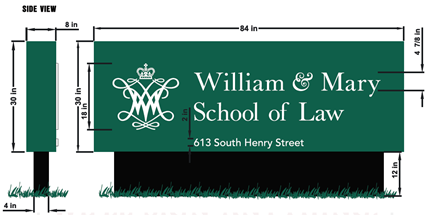
Figure 1. Gateway signage School
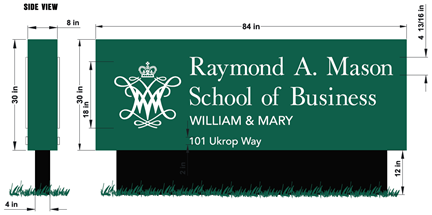
Figure 1a. Gateway signage Named School

Figure 2. Building Sign – Named Building

Figure 2a. Building Sign – Unnamed Building

Figure 3. Exterior Building Sign affixed to building structure

Figure 4. Lot Entrance Parking Sign

Figure 5. In Lot Parking Sign
PLAQUES:
Type of Plaque: Cast Bronze (unless building trim is aluminum or pewter)
Letter: ITC New Baskerville-all letters capitalized black with single line/beveled edge
Style: Leatherette
Background: Option for glass (internal): Cast Aluminum with bronze wash, black with silver ITC New Baskerville letters
Outdoor Size: Standard size is 36” inches wide by 24” inches high or smaller; alternative requested sizes will be reviewed on a case-by-case basis and should not exceed 60” square inches.
Indoor Size: Standard size is 24” inches wide by 36” inches high or smaller and shouldn’t exceed 60” square inches.
Text: To include date and facts only.
Example Plaques
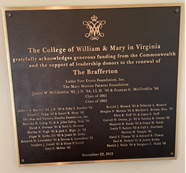
Figure 1. Indoor Plaque
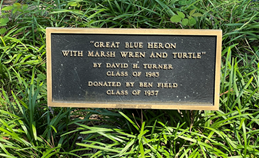
Figure 2. Outdoor Plaque
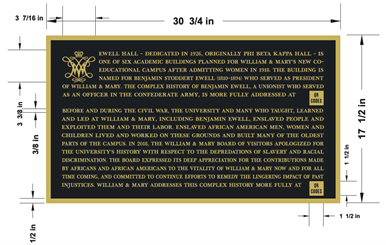
Figure 3. Contextualization Plaque
Wayfinding Maps:
Wayfinding maps originate from the campus map committee, comprised of representatives from University Web & Design, Athletics, Undergraduate Admission, Residence Life, First Year Experience, Auxiliary Services, Student Accessibility Services, Parking & Transportation and Facilities Management, and are typically updated annually with proper GIS location, etc. All formal building names reside in FAMIS and is the governing system of record. Wayfinding maps are in various locations on campus and PDF versions of the Wayfinding maps reside on the William & Mary website, maps will be updated annually.
Example Wayfinding Map
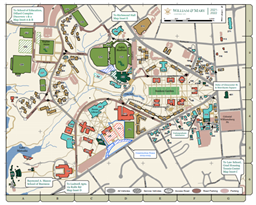
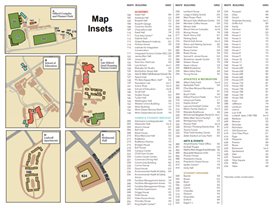
Figure 1: Small Wayfinding Map PDF
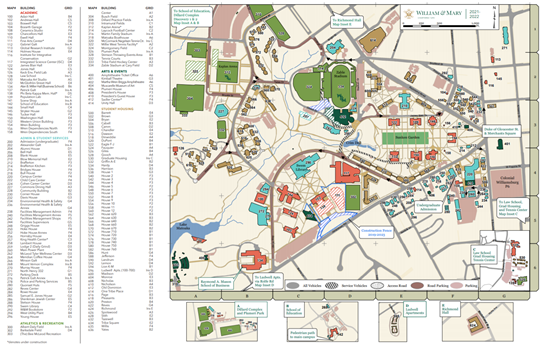
Figure 2: Large Wayfinding Map PDF
APPENDIX C: Removal and/or Storage of System Elements
In the event a System Element needs to be removed, the following guidelines should be followed:
- Renovation - when a building is being renovated, all building System Elements will be stored by Facilities Management and returned to the building, as close as possible to the original location when renovation is complete. If necessary, a smaller System Element, approved by these same guidelines, will be placed with text noting the renovation dates.
- Area or unit moving to a new facility or razing of a building – System Elements should be removed by Facilities Management and where possible, displayed in the new building. University Advancement will be notified regarding donor recognition System Elements that cannot be appropriately displayed in an alternative location/facility. University Advancement will work with the donor to determine the disposition of the plaque.
- Facilities Management will take a photo before destruction of the System Element, sending the photo to Archives prior to disposal of the actual System Element.
Archival Process of System Elements
- Any System Element removed by the university will be photographed, recorded and sent to Swem Archives.
 Skip to main content
Skip to main content
